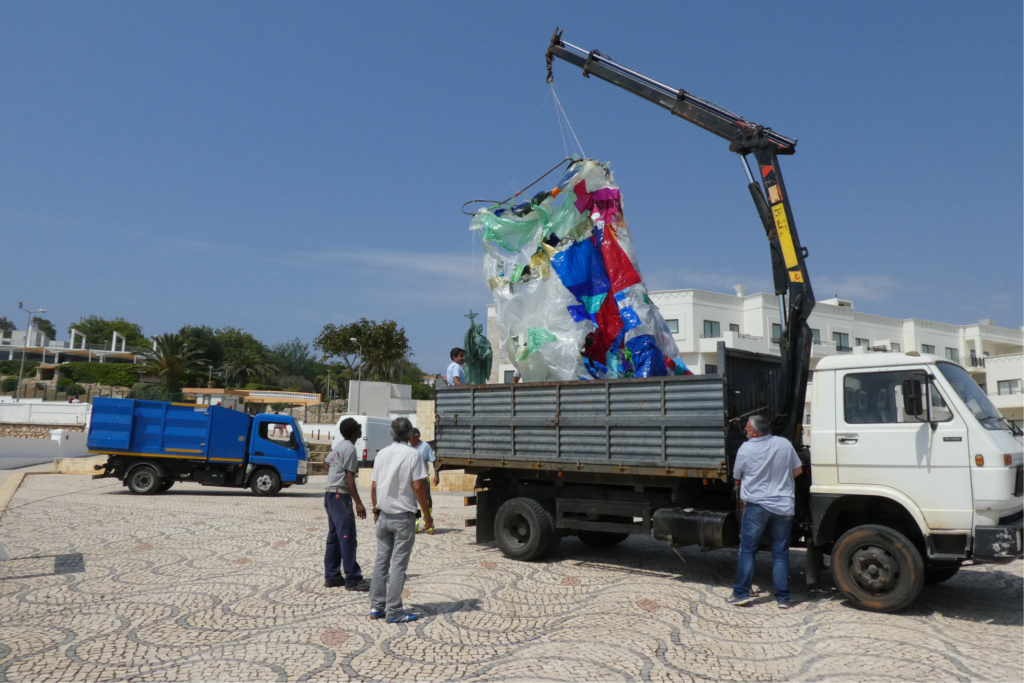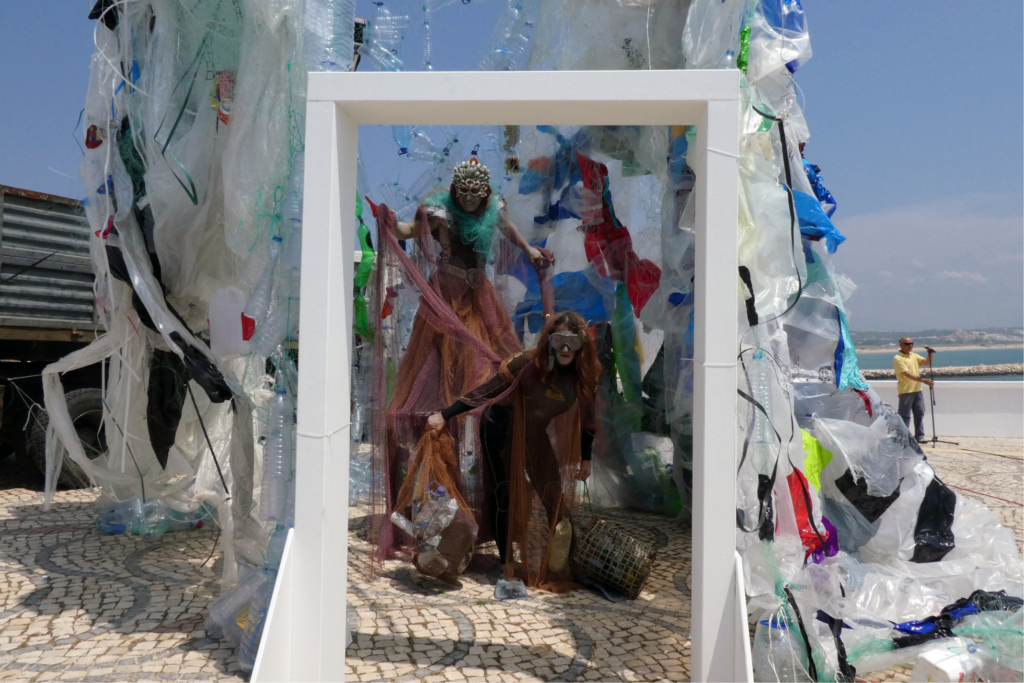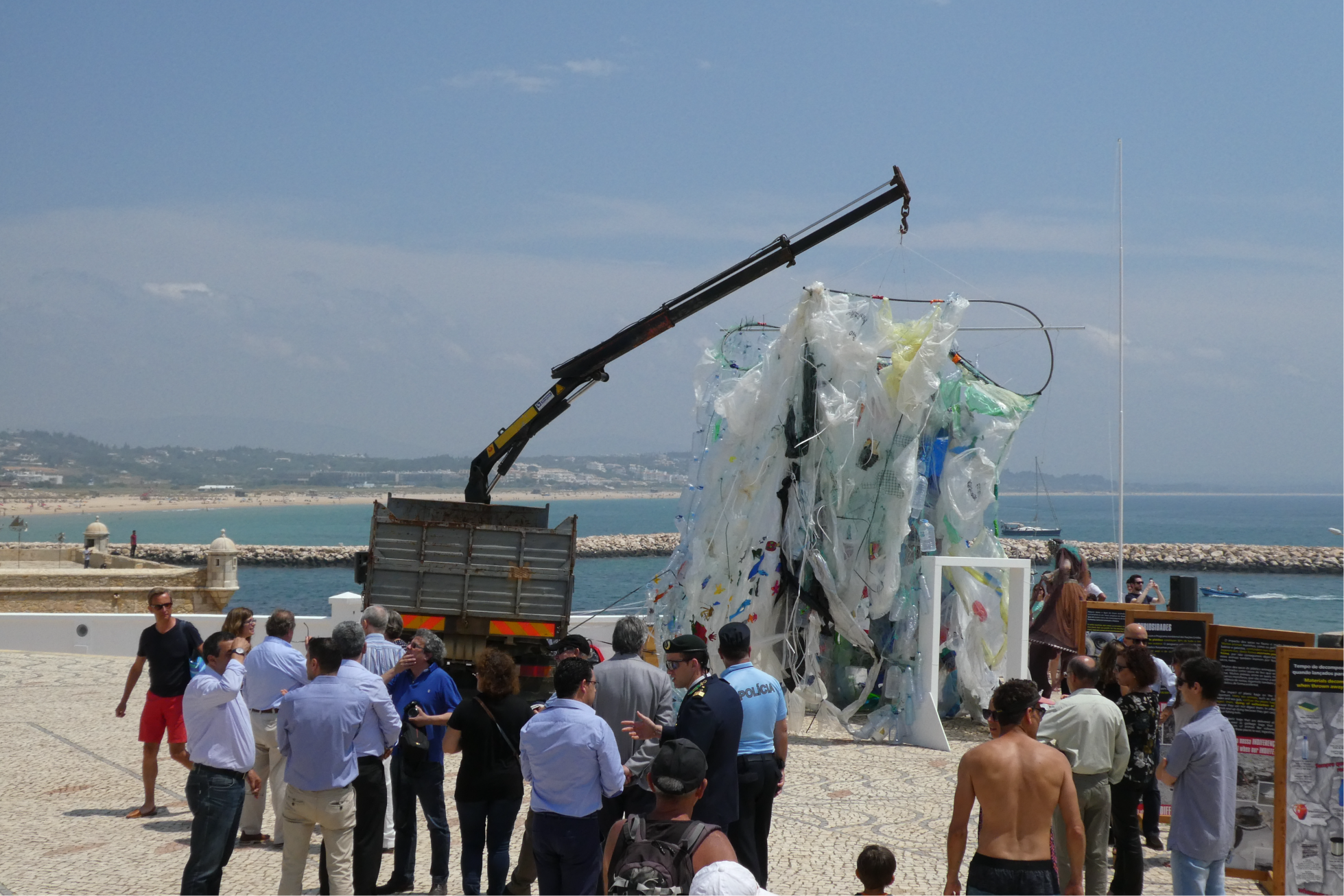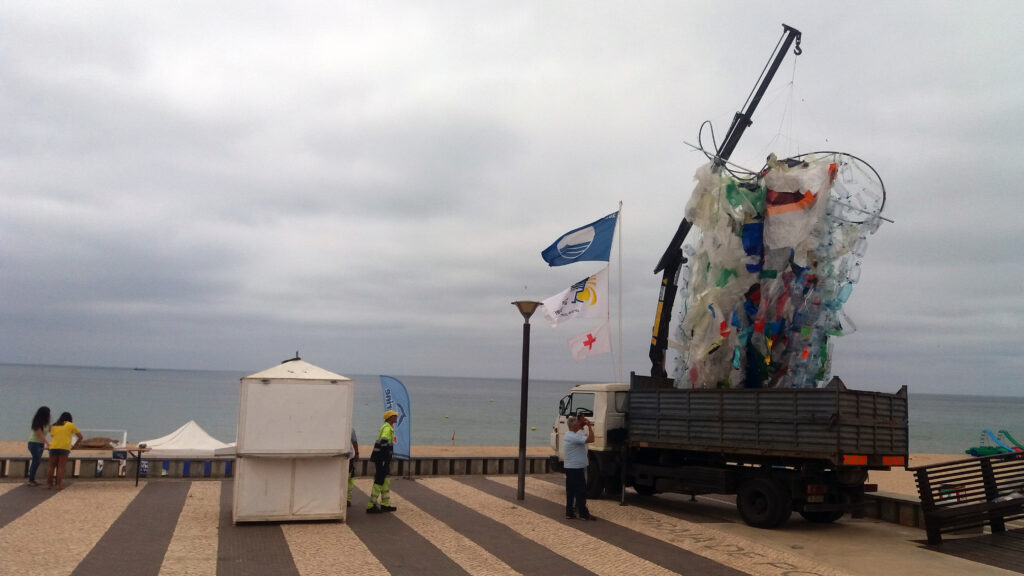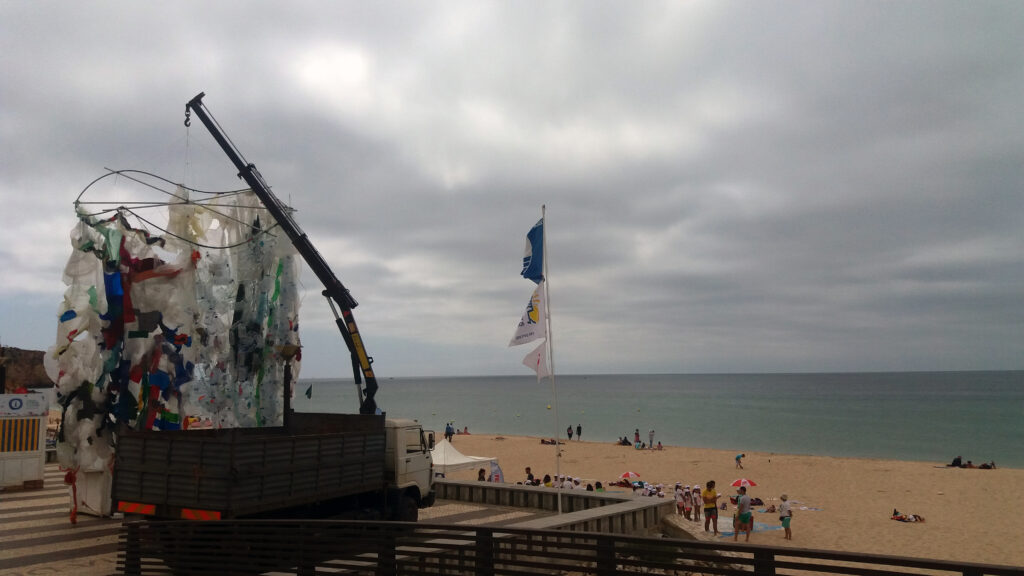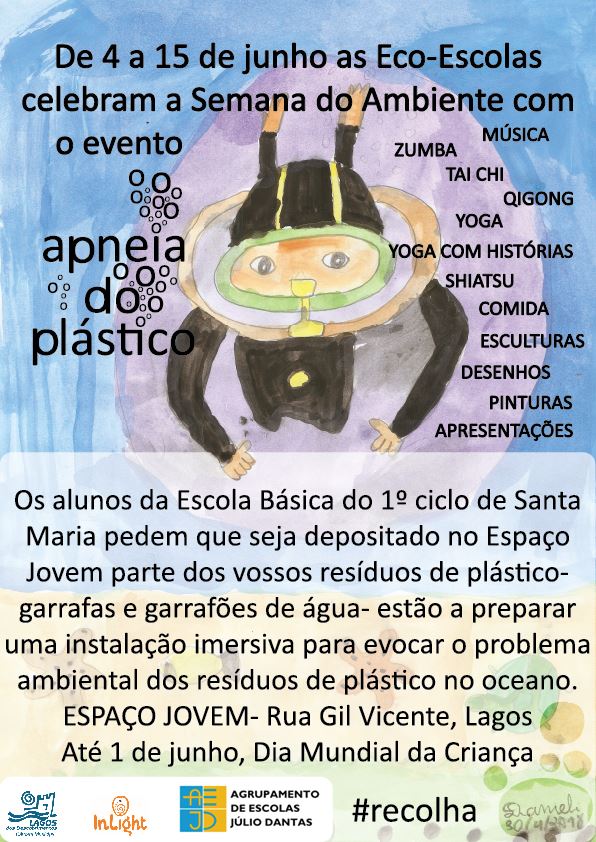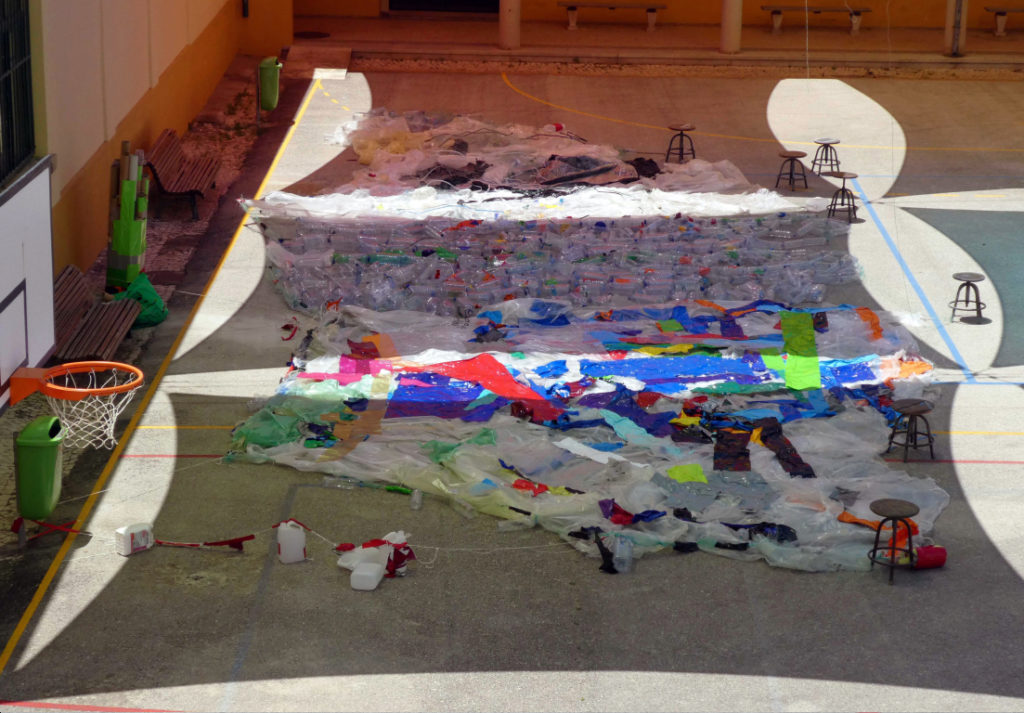
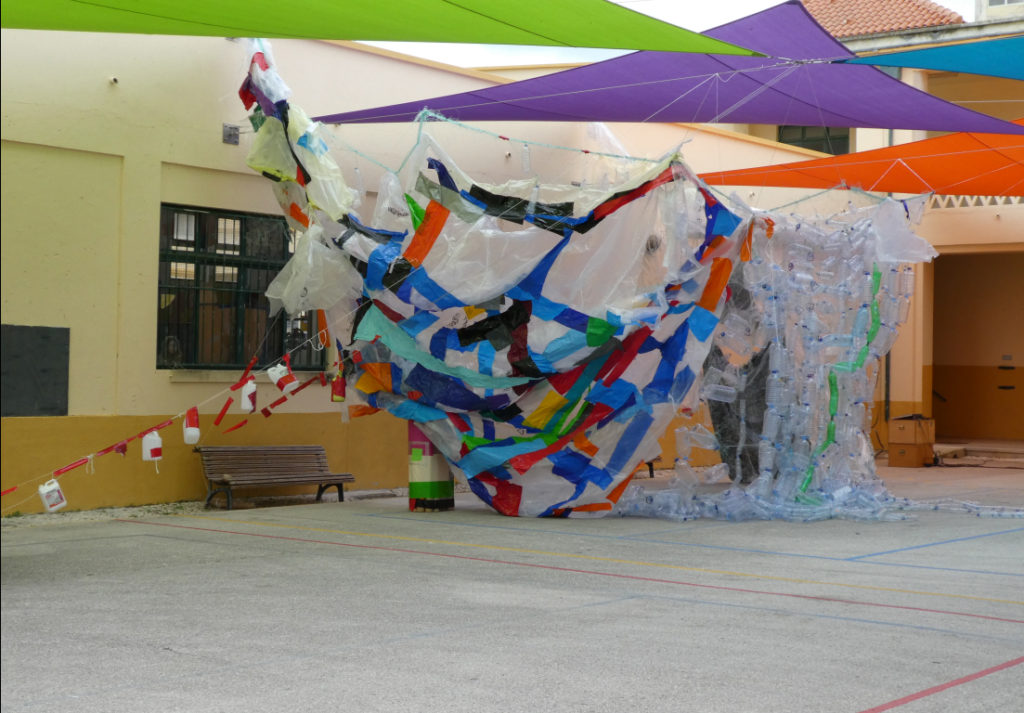
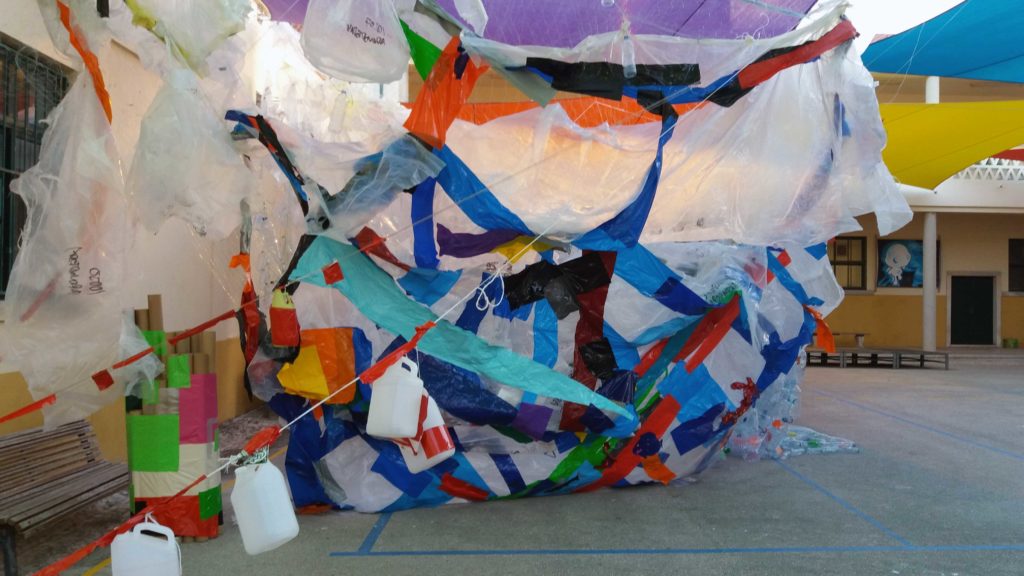
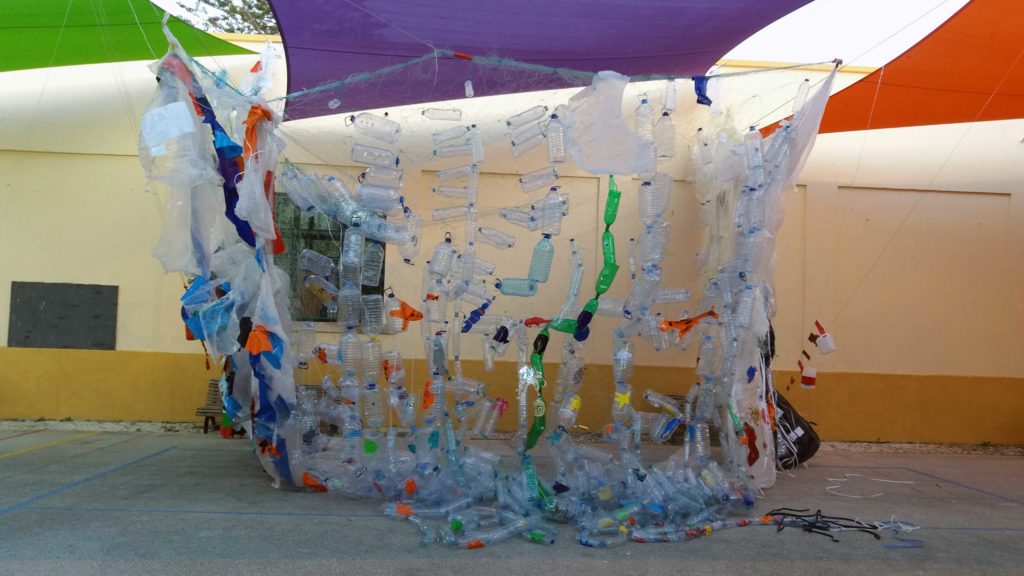
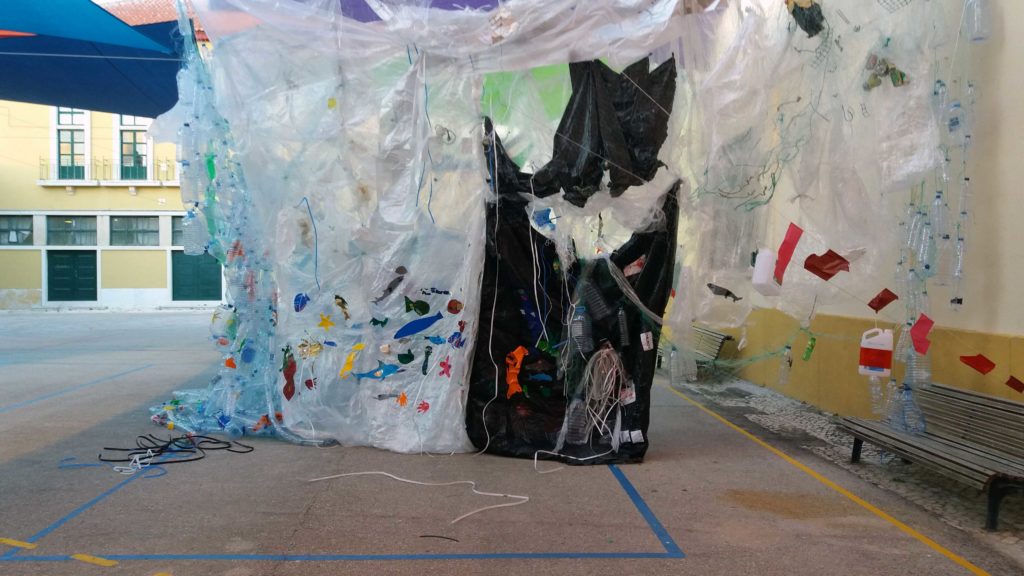
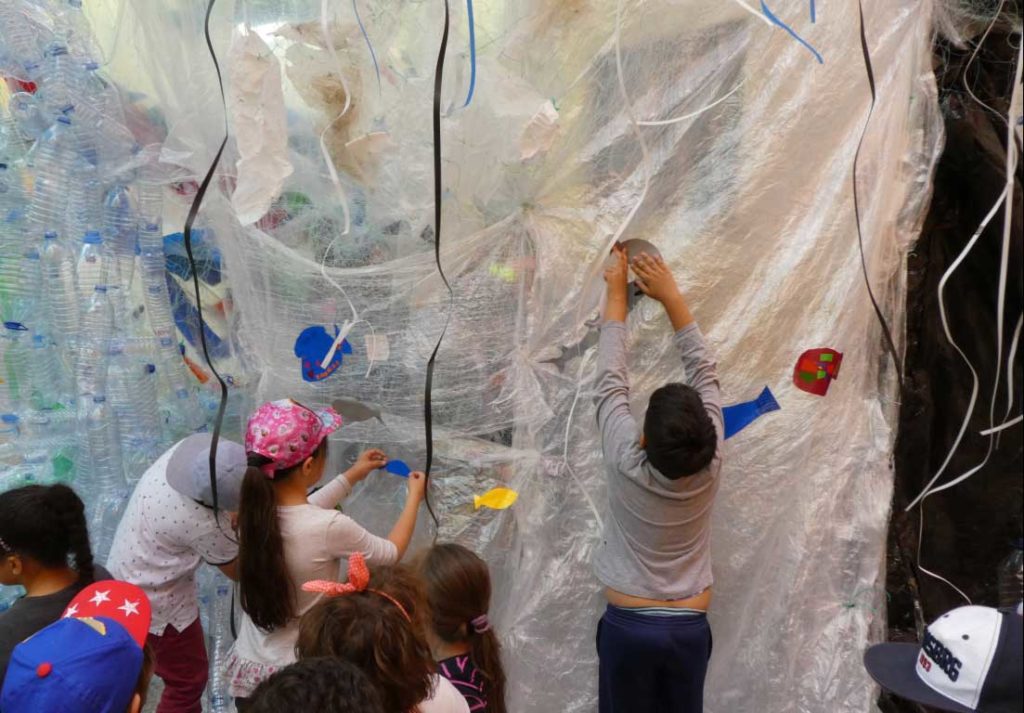
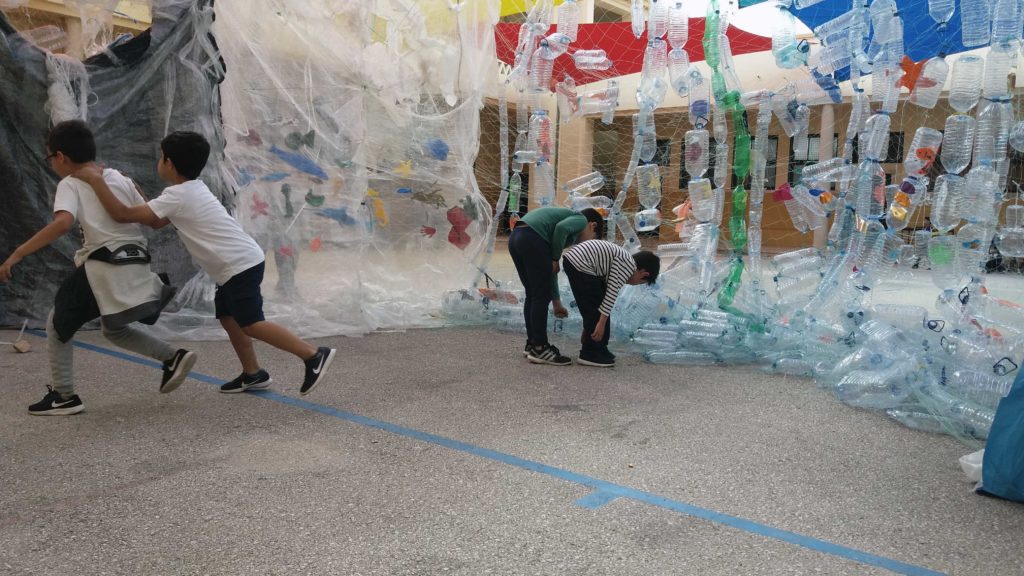
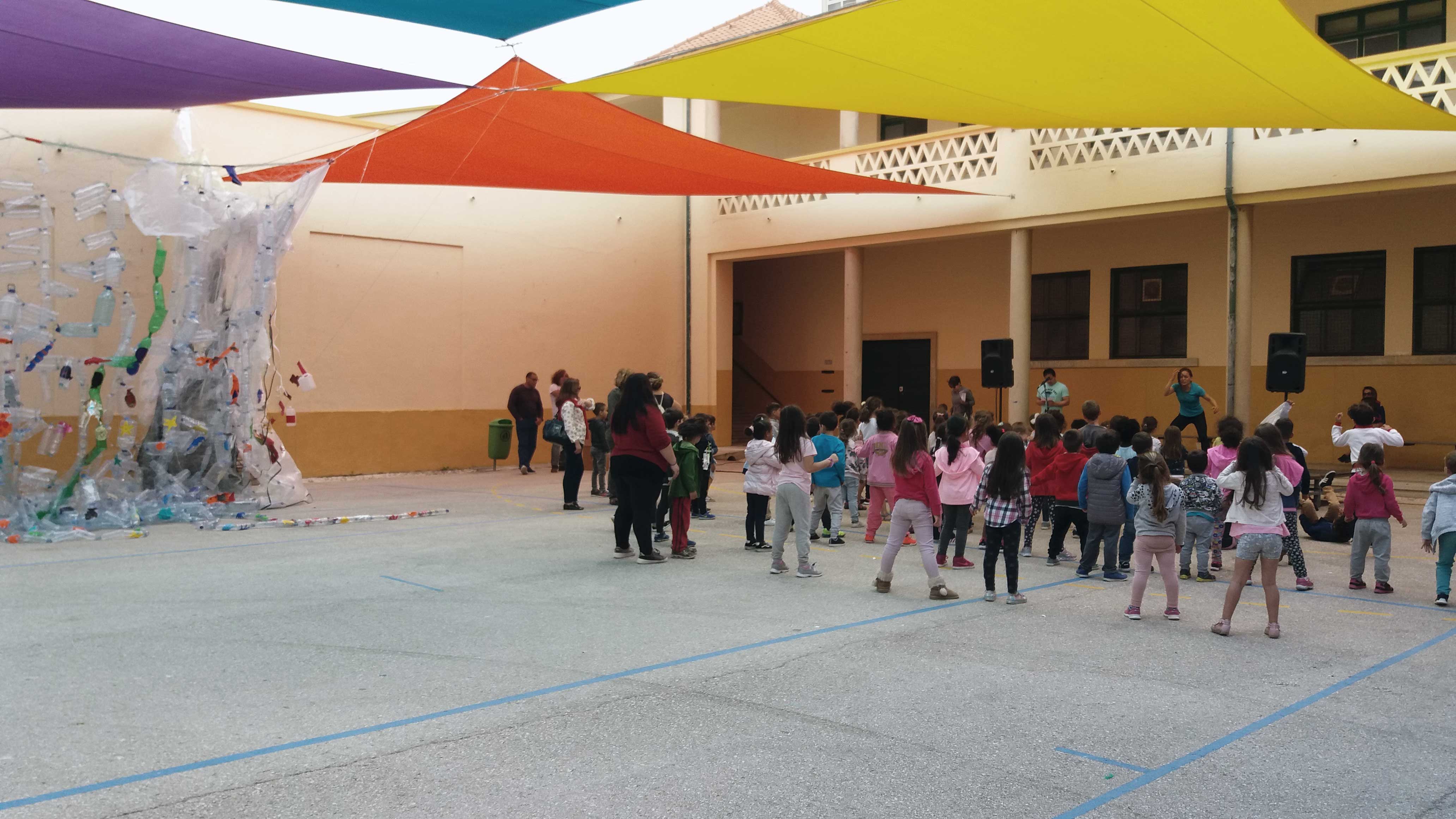
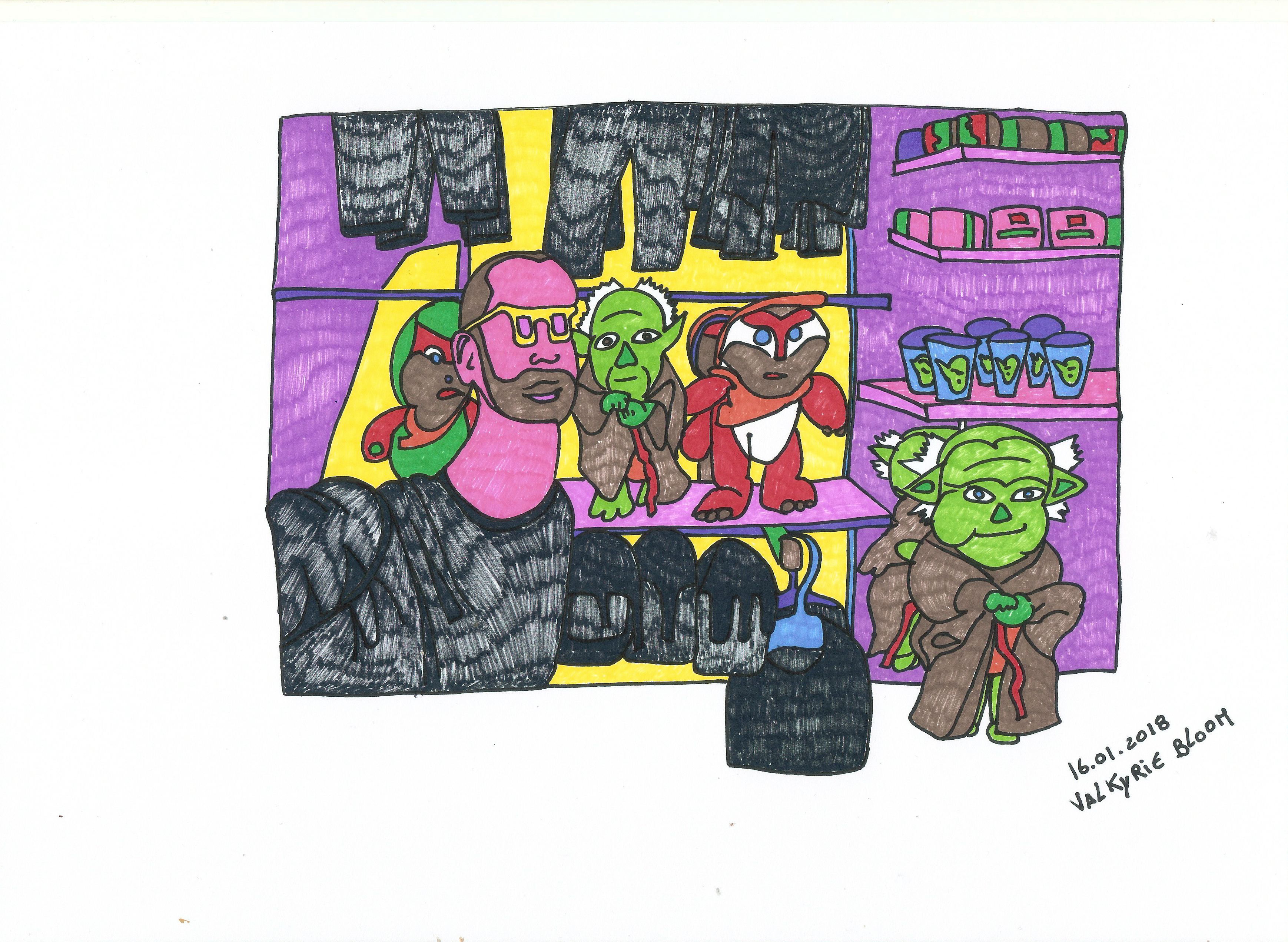
Esta obra de arte participativa convida os espectadores a colocar autocolantes coloridos e simbólicos nas paredes de uma instalação imersiva feita de plástico, representando os seus apegos. O ato de aplicar os autocolantes torna-se uma meditação sobre a natureza do apego, ecoando as práticas espirituais das filosofias orientais, que enfatizam a importância do desapego.
A obra fala da profunda verdade ecológica e espiritual de que todos os seres existem dentro de uma teia interconectada e em constante mudança—cada um deixando uma marca, cada um moldando o todo. Reconhece a natureza da vida, enfatizando que nenhuma ação ou presença está isolada. A peça torna-se tanto uma meditação como um ritual de compreensão e aceitação, instigando-nos a confrontar as camadas de emoções que carregamos—seja através da identidade, da materialidade ou das experiências passadas. Ao fazê-lo, convida-nos a considerar o poder transformador da rendição, a libertação encontrada no deixar ir e a natureza da renovação.
English version:
This participatory artwork invites viewers to place colorful, symbolic stickers on the walls of an imersive installation made of plastic, representing their attachments. The act of applying the stickers, becomes a meditation on the nature of attachment, echoing the spiritual practices of Eastern philosophies, which emphasize the importance of non-attachment.
The work speaks to the profound ecological and spiritual truth that all beings exist within an interconnected, ever-changing web—each leaving an imprint, each shaping the whole. It acknowledges the nature of life, emphasizing that no action or presence is isolated. The piece becomes both a meditation and a ritual of understanding and acceptance, urging us to confront the layers of emotions we carry—whether through identity, materiality, or past experiences. In doing so, it invites us to consider the transformative power of surrender, the liberation found in letting go, and the nature of renewal.
Texto
Com ondas de calor e chuvas de trovoada o verão acabara por chegar. Arrastava-se coxo forçando os lacobrigenses a tirar e por o guarda-chuva da arrecadação.
A caminho da praia o Dário trazia o chapéu de sol na bagageira as toalhas a secar nas costas do banco as cadeiras espreguiçadeira embrenhadas na areia do ano passado no chão a lancheira refrigerada com maçãs, água e sandes de chouriço em guardanapos e alumínio no lugar do passageiro.
Se há alguns anos para cá carregava o carro com este arsenal. De hoje em diante a bola de praia ficaria na arrecadação sempre que chovia recordá-lo-ia de outro tempo. Tempo que mostrava o sol e em minutos passava por casa punha a toalha ao ombro agarrava a água da despensa e descia à praia para uns mergulhos. Encontrava outros amigos um de pele clara trazia protetor solar mas quase sempre acabava a torrar nas horas de maior calor.
Entre cigarros e mergulhos ia enchendo o peito evitando expirar à frente das meninas.
Hoje valente conseguiu em meia hora preparar a merenda antes de sair teve a confirmar a tampa da máquina de lavar, o fogão, as janelas, os trincos.
Quando estava para entrar no carro voltou atrás quis ir tranquilo na certeza que a porta estava fechada à chave.
As mãos suavam ao volante quando abriu a janela não via carros na estrada desceu a avenida não havia pessoas nos passeios olhou em redor não viu gente nos jardins.
Travou o carro parou.
A cidade era um deserto.
O vento hoje trouxe mais que calor.
A janela aberta só piorou não entrava brisa as mãos escorregavam no volante o cheiro de borracha queimada tornou-se incómodo.
Fora do carro a cidade cheirava diferente como o mar de perto.
O sol encadeia-o o olhar à procura de movimento na distância estava tudo parado a funcionar estático paralisado com ninguém.
A ventoinha do motor deu contagem decrescente para silêncio vermelho um semáforo a maresia encheu-lhe pulmões o sal secou-lhe a pele o cheiro do peixe deixado na lota e no mercado enferrujou-lhe o paladar.
A ponte estava levantada mas nenhum barco por passar o telemóvel vibrou cortou o arrepio
A mensagem dizia:
“Tsunami! ONDA GIGANTE! Estamos todos em Monchique, da Fóia consigo ver-te ai parado à porta
do carro. Vem rápido amor.”
English version:
Text
With heatwaves and thunderstorm rains, summer had finally arrived. It limped in, forcing the people of Lagos to take the umbrella out of storage and put it back again. On his way to the beach, Dário had the beach umbrella in the trunk, towels drying on the back of the car seat, deck chairs tangled in last year's sand, and in the passenger seat, a cooler bag with apples, water, and chorizo sandwiches wrapped in napkins and aluminum foil.
A few years ago, he used to load the car with this arsenal. From now on, the beach ball would stay in storage, and every time it rained, it would remind him of another time. A time when the sun shone, and in minutes, he would be home, towel over his shoulder, grabbing water from the pantry, and heading to the beach for a swim. He'd meet up with friends—one with fair skin who always brought sunscreen but nearly always ended up roasting under the midday sun.
Between cigarettes and swims, he'd fill his chest with air, trying to avoid exhaling in front of the girls. Today, however, he managed, in half an hour, to prepare the snack before leaving. He had to double-check the washing machine lid, the stove, the windows, and the locks.
When he was about to get in the car, he went back inside. He wanted to be sure the door was locked. His hands were sweating on the steering wheel. When he opened the window, there were no cars on the road. He drove down the avenue—no people on the sidewalks. He looked around but saw no one in the gardens.
He braked the car. Stopped.
The city was a desert.
The wind today brought more than just heat.
The open window only made it worse. No breeze came through, and his hands slipped on the wheel. The smell of burning rubber became unbearable.
Outside the car, the city smelled different, like the sea up close.
The sun blinded him as he searched the distance for movement. Everything was still—static, paralyzed—without anyone.
The fan of the engine counted down to silence. A red traffic light. The sea breeze filled his lungs. The salt dried his skin. The smell of fish left at the market and in the fishmonger's stand rusted his taste buds.
The bridge was raised, but no boats passed. His phone vibrated, cutting through the chill.
The message read:
"Tsunami! GIANT WAVE! We're all in Monchique, from Fóia I can see you there, stopped by the car. Come quickly, love."
Benifícios
A Introdução da Aguarela como Atividade em Escolas Primárias e os Benefícios para o Desenvolvimento Cerebral
A inclusão de atividades artísticas no currículo escolar é reconhecida como uma prática pedagógica essencial para o desenvolvimento integral das crianças. Entre essas atividades, a aguarela se destaca como uma forma de expressão artística única e enriquecedora, com efeitos cientificamente comprovados no desenvolvimento cerebral. Incorporar a prática de pintar com aguarelas nas escolas primárias pode trazer benefícios significativos tanto no campo cognitivo quanto no emocional.
A Aguarela e o Desenvolvimento Cognitivo
A aguarela exige concentração, precisão e coordenação motora fina, habilidades fundamentais para o desenvolvimento cognitivo de crianças em idade escolar. Estudos neurocientíficos mostram que a prática de atividades artísticas, como a pintura, estimula ambos os hemisférios cerebrais. Enquanto o hemisfério esquerdo é ativado pela necessidade de planejar e organizar as formas e cores, o hemisfério direito é estimulado pela criatividade e pela expressão emocional.
Além disso, o uso de pincéis e a manipulação de água e tinta requerem habilidades motoras complexas, promovendo o desenvolvimento do córtex motor e a integração sensorial. Crianças que praticam atividades artísticas demonstram uma maior capacidade de resolver problemas, planejar tarefas e desenvolver flexibilidade cognitiva, competências essenciais para o sucesso em diversas áreas da vida.
Benefícios Emocionais e Sociais
A prática da aguarela também é uma poderosa ferramenta para o bem-estar emocional. O ato de pintar oferece às crianças uma forma de expressão não-verbal, permitindo que externalizem sentimentos e emoções que, muitas vezes, não conseguem verbalizar. Estudos indicam que atividades artísticas reduzem os níveis de cortisol, o hormônio do estresse, e promovem o aumento de neurotransmissores relacionados ao bem-estar, como a dopamina e a serotonina.
No contexto social, pintar em grupo pode incentivar a cooperação, a troca de ideias e a valorização do trabalho do outro. A arte promove um senso de comunidade e inclusão, especialmente em crianças que enfrentam dificuldades em outras áreas do aprendizado. A aguarela, em particular, com suas nuances suaves e imprevisibilidade, ensina resiliência e aceitação, uma vez que os resultados nem sempre podem ser completamente controlados, mas são sempre únicos e belos.
Introduzir a aguarela como atividade regular em escolas primárias não é apenas uma adição criativa ao currículo, mas uma ferramenta poderosa para promover o desenvolvimento cerebral, emocional e social das crianças. Os efeitos positivos vão muito além do papel, contribuindo para a formação de indivíduos mais equilibrados, criativos e resilientes. Assim, é fundamental que educadores e gestores escolares reconheçam o valor da arte na educação infantil e a implementem como um pilar essencial para o desenvolvimento integral das futuras gerações.
Benefits
The Introduction of Watercolor Painting as an Activity in Primary Schools and Its Benefits for Brain Development
The inclusion of artistic activities in school curricula is recognized as an essential pedagogical practice for the holistic development of children. Among these activities, watercolor painting stands out as a unique and enriching form of artistic expression, with scientifically proven effects on brain development. Incorporating watercolor painting into primary schools can provide significant benefits both in the cognitive and emotional realms.
Watercolor Painting and Cognitive Development
Watercolor painting requires concentration, precision, and fine motor coordination—skills that are fundamental for the cognitive development of school-aged children. Neuroscientific studies show that artistic activities like painting stimulate both hemispheres of the brain. While the left hemisphere is activated by the need to plan and organize shapes and colors, the right hemisphere is engaged through creativity and emotional expression.
Additionally, using brushes and handling water and paint involve complex motor skills, promoting the development of the motor cortex and sensory integration. Children who engage in artistic activities exhibit a greater ability to solve problems, plan tasks, and develop cognitive flexibility—key competencies for success in various areas of life.
Emotional and Social Benefits
Watercolor painting is also a powerful tool for emotional well-being. The act of painting offers children a nonverbal means of expression, enabling them to externalize feelings and emotions that they may struggle to articulate. Studies indicate that artistic activities reduce levels of cortisol, the stress hormone, while increasing neurotransmitters associated with well-being, such as dopamine and serotonin.
In a social context, painting in groups can foster cooperation, idea-sharing, and appreciation of others' work. Art promotes a sense of community and inclusion, especially for children who may face challenges in other areas of learning. Watercolor painting, with its soft tones and unpredictability, teaches resilience and acceptance, as results are not always fully controllable but are nonetheless unique and beautiful.
Introducing watercolor painting as a regular activity in primary schools is not merely a creative addition to the curriculum but a powerful tool for fostering children’s cognitive, emotional, and social development. The positive effects extend far beyond the paper, contributing to the growth of balanced, creative, and resilient individuals. It is therefore essential for educators and school administrators to recognize the value of art in childhood education and implement it as a cornerstone for the holistic development of future generations.
